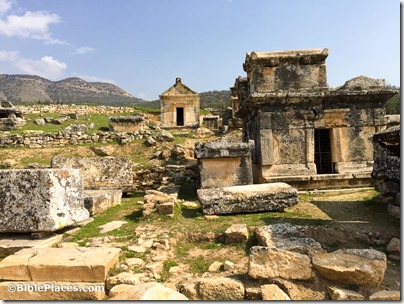I’ve recently recommended Christopher Stanley’s A Rooster for Asklepios as an enjoyable way to enter the Greco-Roman world and all of its fascinating background to the New Testament. Frequently I found things clicking into place as he included some ancient custom or activity in the fictional story of a slave who journeys with his master to a healing sanctuary of Asklepios.
Early in the story, a young doctor is describing his previous employment at the temple of Asklepios in Hierapolis.
This is a pretty obvious concept when you think about it, but I don’t know that I had ever thought about it. Hierapolis is an impressive city, not far from Laodicea, and the ancient cemetery is well worth some time exploring. Northern necropolis at Hierapolis Buried tombs in eastern necropolis of Hierapolis Well-preserved tombs in the northern necropolis For more about Hierapolis, see our page with photos and related websites. |


